Sexuality
is an integral part of the personality of everyone:
man, woman and child.
It is a basic need and aspect of being human that
cannot be separated from other aspects of life.
Sexuality is not synonymous with sexual intercourse,
it is not whether we have orgasm or not, and it is
not the sum total of our erotic lives. These may be
part of our sexuality but equally they may not be.
Sexuality is so much more. It is the energy that motivates
us to find love, contact, warmth and intimacy; it
is expressed in the way we feel, move, touch and are
touched; it is about being sensual as well as being
sexual.
Sexuality influences thoughts, feelings, actions and
interactions and thereby our mental and physical health.
Since health is a fundamental human right, so must
Sexual Health also be a basic human right. T. Langfeldt
and M. Porter (1986): Sexuality and family planning.
WHO
|
|
|
|
Sexually
Transmitted Infections (STIs)
STI stands for a Sexually Transmitted Infection.
STIs have also been referred to as STDs(Sexually Transmitted
Diseases) or VDs(Venereal Diseases but these terms
are used less often nowadays.
An STI is any infection which is passed from one person
to another person during sexual activity. Sexual activity
can include oral, vaginal sex, anal sex, and mutual
masturbation.
You can have an STI and not know it. Even if you don't
notice any symptoms it can still cause damage to your
health and you can pass the infection onto other people.
If you think you may have an STI you should visit
your local STI clinic for a full screening. In this
section you will find information on a number of STIs.
back to top
|
Bacterial
Vaginosis
Bacterial Vaginosis or BV is a condition caused by
the overgrowth of normal vaginal bacteria. Its not
known what causes it but it seems to affect women
with many sexual partners and women with new sexual
partners. Using an intrauterine device (IUD - see
section on contraception) may also trigger BV.
What Symptoms should I look for?
In
lots of cases there may be no symptoms but some women
may experience an abnormal vaginal discharge and a
strange smell. BV may also cause itching in the genital
area.
Is there any cure?
BV
is treated with antibiotics. If it is not treated
it can lead to PID (Pelvic Inflammatory Disease) and
can also lead to complications during pregnancy.
|
Chlamydia
Chlamydia is a very common sexually transmitted bacterial
infection. Chlamydia can infect the penis, vagina,
cervix, anus, urethra, or eye. If left untreated Chlamydia
can cause infertility.
|
How
is it transmitted?
Chlamydia
is spread by oral, anal, and vaginal sexual contact.
Chlamydia can also be spread from a mother to her
infant at birth. In some cases, an infected person
can spread the bacteria to their eyes from secretions
on their genitals.
|
What Symptoms should I look for?
Usually, chlamydia has no symptoms. It is often called
the silent infection. Up to 85 percent of women and
40 percent of men with Chlamydia have no symptoms.
When women have symptoms, they may experience:
Bleeding between menstrual periods.
Vaginal bleeding after intercourse.
Stomach Pain.
Painful Intercourse.
Fever.
Painful urination.
The urge to urinate more than usual.
Abnormal vaginal discharge
When men have symptoms, they may experience:
Pus or milky discharge from the penis.
Pain or a burning feeling while urinating.
Swollen or tender testicles.
In women and men, chlamydia may cause the rectum to
itch and bleed. It can also result in a discharge
and diarrhea.
If it infects the eyes, chlamydia may cause redness,
itching, and a discharge.
|
Is
there any cure?
The infection is curable. It is treated with antibiotics.
It is best that Chlamydia is treated early so that
it doesn't get a chance to damage fertility.
back to top
|
Genital Herpes
Herpes is an infection caused by two different but
closely related viruses - herpes simplex virus type
1 (HSV-1) and herpes simplex virus type 2 (HSV-2).
Both types are very infectious. Both have similar
symptoms. When the infection is on the mouth, it is
called oral herpes, if it is on or near the sex organs
it is called genital herpes. Touching, kissing, and
sexual contact, including vaginal, anal, and oral
intercourse can spread herpes. It can be passed from
one partner to another or from one part of the body
to another.
|
What Symptoms should I look for?
The most common symptom of oral herpes is cluster
of blistery sores around the mouth. The most common
symptom of genital herpes is a cluster of blistery
sores on the sex organs or rectum (back passage).
Symptoms may last several weeks, go away, and then
return - weeks, months, or years later. There may
be some early warning signs before and outbreak occurs.
These warning signs can include itching tingling and
burning where the sores were before. The warning signs
may start a few hours or a day before the sores flare
up. You should stop having sexual contact and consult
your doctor if you feel one of these warning signs.
|
Is
there a Cure?
There is no cure for Herpes. Treatments are available
to ease discomfort during an outbreak and to speed
up the healing process.
back to top
|
Genital
Warts
Genital warts are caused by the human papiloma virus
(HPV ). Genital warts present as white cauliflower
shaped lumps on the penis, testicles, or anus.
How are they Transmitted?
Genital warts are highly infectious and are very easily
transmitted through close bodily contact.
What
Symptoms should I look for?
Cauliflower
shaped lumps on the penis or testicles. Anal warts
usually cause itchiness.
Is
there a Cure?
Genital
and anal warts can be successfully treated but this
usually requires making a number of trips to a sexual
health clinic. The virus which causes genital warts
can stay in a persons system so the warts sometime
reoccur after treatment.
back
to top
|
Gonorrhoea
Gonorrhoea is a sexually transmitted infection (STI)
caused by a bacteria.
|
How
is it Transmitted?
Gonorrhoea is spread by oral, anal, and vaginal
sexual contact. Gonorrhoea can also be spread from
a mother to her infant at birth. In some cases, an
infected person can spread the bacteria to their eyes
from secretions on their genitals.
|
What
Symptoms should I look for?
Like other STIs there are often no symptoms. In men,
there is usually a yellowish discharge from the penis.
Urination can be painful and there might be an urge
to go to the toilet more frequently. In women the
infection can be so mild that it goes unnoticed. Symptoms
can include a vaginal discharge, abnormal menstruation
(periods), pain when peeing, and stomach pain. With
infection via oral sex, symptoms can include a sore
throat and tonsillitis. Gonorrhoea can also infect
the eye.
|
Is there a Cure?
Gonorrhoea can be cured. It is treated with Antibiotics.
It is very important that it is treated early so that
it doesn't cause infertility.
back to top
|
Hepatitis
A
Hepatitis
A is a serious viral disease that attacks the liver.
Hepatitis A is often sexually transmitted.
How
is it Transmitted?
Hepatitis
A can be spread through sexual contact with an infected
person or through an exchange of body fluids such
as blood, saliva, or urine.
What
Symptoms should I look for?
There
may be flu like symptoms e.g. tiredness, and pain
in the joints. There may also be a noticeable yellowing
of the skin and darkening of the urine.
Is
there a Cure?
There
is no specific medical treatment for Hepatitis A.
A healthy diet and rest can help with recovery. Usually
requires two to three months for a full recovery.
A vaccine is available to prevent Hepatitis A.
back
to top
|
Hepatitis B
Hepatitis B is a serious viral disease that attacks
the liver.
Hepatitis B is often sexually transmitted. The virus
is 100 times more infectious than HIV and is found
in blood, semen and vaginal fluids.
|
How is it Transmitted?
Hepatitis B can be spread through sexual contact with
an infected person or through an exchange of body
fluids such as blood, saliva, or urine. It is perfectly
safe to visit someone with Hepatitis - the virus is
not transmitted through casual contact.
|
What
Symptoms should I look for?
There may be flu like symptoms e.g. tiredness, and
pain in the joints. There may also be a noticeable
yellowing of the skin and darkening of the urine.
Like other STIs it is also possible that there will
be no symptoms.
|
Is
there a Cure?
There is no specific medical treatment for Hepatitis
B. A healthy diet and rest can help with recovery.
A person who is not clear of the virus in six months
is chronically infected. A vaccine is available to
prevent Hepatitis B.
back to top
|
| HIV |
|
| HIV
(Human Immunodeficiency Virus) is the virus that
can lead to AIDS. AIDS Stands for Acquired Immuno-Deficiency
Syndrome: Acquired means you get it from someone
else. Immunodeficiency means that your body cannot
defend itself against certain diseases. Syndrome
means a collection of symptoms. |
 |
|
How
is it Transmitted?
Hiv is passed from one person to another through the
exchange of blood, semen, vaginal fluids, and breast
milk. HIV is not transmitted by day-to-day contact
in the workplace, schools, or social settings. HIV
is not transmitted through shaking hands, hugging,
or a casual kiss. You cannot become infected from
a toilet seat, a drinking fountain, a door knob, dishes,
drinking glasses, food, or pets. HIV is not an airborne
or food-borne virus, and it does not live long outside
the body.
|
What
symptoms should I look for?
You may be HIV positive and not know it; you may look
and feel healthy. Your sex or drug partner may be
HIV positive and not know it. The only way to know
for sure whether you are infected is to be tested
for HIV infection. You cannot rely on symptoms to
know whether or not you are infected with HIV.
|
For most people HIV antibodies take 3 months to develop.
Antibodies are a part of the body's defense system.
To get an accurate test you must wait at least 3 months
after the risk activity to get tested. This is referred
to as the window period. Some test centres may recommend
testing again at 6 months, just to be extra sure.
It is also important that you are not at risk of further
exposures to HIV during this time period. Most importantly
you should continue to practice safe sex and not share
needles.
|
Is
there a Cure?
There is no cure available for HIV. Drugs keep the
virus under control and these drugs are improving
all the time.
back to top
|
Pubic Lice
These lice are wingless insects with six legs and
a square body. They look like sea crabs, which is
why they are often referred to as "the crabs." The
lice cling to pubic hair and feed on blood. The female
of the species lays about 50 eggs, called nits, and
attaches them to the base of a hair strand. The average
life-span is 25 to 30 days. It's easier to get lice
than any other STI. From just one sexual encounter
with an infested person, you have a 95 percent chance
of picking them up.
|
How are they Transmitted?
Lice are transmitted through body contact with a person
who has them. The lice can live away from their host
for 24 to 48 hours, so there are other possible modes
of transmission such as sheets and towels (but not
toilet seats).
|
What Symptoms should I look for?
You will know if you have contracted pubic lice because
you can see them. You may also see little bluish marks
in the pubic area or thighs where they've bitten you.
The lice often cause itching, which is thought to
be from an allergic reaction to their bites. Although
crabs are found most often in the pubic area, they
can be found on any other hairy part of the body,
such as the chest, armpits, beard, and eyelashes.
They normally leave the hair on the head to their
cousins, head lice.
|
Is there a Cure?
You can get over the counter preparations from the
chemist to treat this or you can see your doctor.
back to top
|
Scabies
Scabies is caused by a parasitic mite.
How is it transmitted?
Scabies is passed on through close bodily contact
with an infected person. In rare cases it can also
be passed on through the sharing of clothes or bed
linen.
What Symptoms should I look for?
Intense itching, silvery lines on the skin, and
between the fingers. If a person scratches at the
itcy areas sores can develop which can become infected.
Is there a Cure?
The infection is treated with lotions. If it is
not treated it spreads and the infection can get worse.
|
Syphillis
Syphilis is a sexually transmitted disease caused
by bacteria.
|
How is it transmitted?
Syphillis can be spread through kissing, oral, vaginal,
and anal sex. Syphilis can be passed to other sexual
partners during the first two years after the disease
is contracted. After two years, the disease is unlikely
to be transmissible to sex partners but can be passed
from a woman to her unborn child.
|
What Symptoms should I look for?
The first sign of syphilis infection, is usually a
small painless sore on the sexual organs. This sore,
called a chancre, appears two to thirteen weeks after
infection. This sore can last for up to five weeks
and then disappears. Following this a rash may appear
on the palms of the hands and the soles of the feet.
Syphillis may show no symptoms for many years after
this but if it is left untreated it can cause very
serious damage to your health. Heart disease, blindness,
deafness, skin lesions, and paralysis may develop.
|
Is
there a Cure?
Syphillis is curable. It is treated with a course
of Antibiotics.
back to top
|
Contraceptives
In
this section of the site you will find information
on various different types of contraception. Only
the Male Condom and Femidom can help prevent against
pregnancy and STIs. It is a good idea to discuss your
contraception options with a Doctor or another health
professional.
back
to top
|
Contraceptive
Injection
This injection contains a hormone called Progestogen.
Once it has been injected the hormone is released
very slowly into the body.
|
There
are two types of injection available:
|
Depo-Provera provides protection for 12 weeks.
Noristerat provides contraceptive protection for 8
weeks.
|
The
injection works by:
|
stopping
the ovaries releasing an egg each month.
thickening
the mucus from the cervix which stops sperm reaching
the egg.
stopping
the egg settling in the womb
|
Advantages
|
The
injection may provide some protection against cancer
of the womb.
It
can be used while you are breastfeeding.
|
Disadvantages
|
The
injection can cause irregular bleeding or periods
may last longer. Irregular bleeding can continue for
months after the injection has stopped.
Some
women may experience changes in weight, headaches,
acne, mood swings, or breast tenderness.
If
you experience side effects, they'll last as long
as the injection and sometimes for longer.
|
The
contraceptive injection is not suitable for everyone.
You should not use it if:
|
You
don't want your periods to change.
You think you might be pregnant.
|
You
also shouldn't use the injection if you have or have
had:
|
Cancer
of the womb or breast cancer.
A
heart attack or stroke.
Depression.
Liver
Disease.
back to top
|
| Diaphragms
& Caps
|
|
|
These
flexible rubber devices work by covering the
cervix. They are used with a spermicide (a chemical
which kills sperm). They are specially fitted
by a doctor to make sure that they are the right
size. This fitting should be checked once a
year and if your weight changes by more than
7lbs. The fitting also needs to be checked if
you have a baby, miscarriage, or abortion. Thrush
Pessaries (creams used to treat Thrush) can
damage diaphragms and caps. Diaphragms and caps
can, if used correctly, prevent pregnancy but
do not offer protection against STIs. These
devices may also protect against cancer of the
cervix.
|
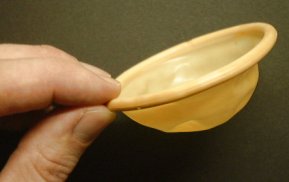
|
|
Inserting A Diaphragm
Put two strips of spermicide (cream or jelly) on both
sides of the diaphragm. Put your index finger on top
of the diaphragm and squeeze the diaphragm between
your thumb and other fingers. Slide the diaphragm
into your vagina downwards and backwards. After you
have done this you must check that you can feel your
cervix (the opening to your womb) covered by the rubber.
The diaphragm can be inserted while you are lying
down, squatting, or with one leg on a chair. You will
need to leave the cap in for at least six hours after
you have had sex and for no more than 24 hours. To
remove it hook your finger under the rim and pull
gently.
|
Inserting A Cap
Fill one third of the cap with spermicide. Using any
more spermicide than this or using spermicide around
the rim will stop the cap from staying in place. Squeeze
the sides of the cap together and hold it between
your thumb and first two fingers. The cap fits over
the cervix and stays in place by suction. Once the
cap is in you should add more spermicide. The diaghragm
needs to be removed within 24 hours of sexual intercourse.
back to top
|
Emergency
Contraception
|
| Female
Condom (Femidom) |
|
The
Femidom is made from soft polyurethane. It lines
the vagina and hangs just outside. The femidom
can be inserted at anytime before sex but always
before the penis touches the vagina. The femidom
may prevent pregnancy and offer both partners
protection from most sexually transmitted infections,
including HIV. The femidom may also protect against
cancer of the cervix. Unlike the male condom the
femidom can be used with oil and water based lubricants.
|
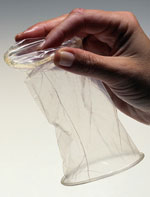 |
|
When
taking the condom out of it's packet be sure not to
tear it; sharp fingernails and jewellery can easily
tear a condom. It is also very important that you check
the expiry date. Thrush Pessaries (creams used to treat
Thrush) can damage the femidom.
The
femidom can be inserted while you are lying down, squatting,
or with one leg on a chair. A bit of practice will let
you know which method is best for you. Hold the closed
end of the condom and spueeze the inner ring between
the thumb and middle finger. With your other hand separate
the folds of skin (labia) around your vagina. Put the
squeezed ring into your vagina and push it up as far
as you can. Next put your index and middle finger inside
the open end of the femidom and push the ring as far
back as it will go.
It is a good idea for the woman or man to guide the
penis inside the femidom. You need to be sure that the
penis has entered the femidom and not the space between
the femidom and the vagina. Once the man's penis stays
within the femidom you are protected. After intercourse
twist the open end of the femidom to keep the sperm
inside and pull it out gently.
back to top
|
|
Implant
The
implant is a small flexible tube which is placed
under the skin of the arm. The implant releases
the hormone progestogen. It stops ovulation,
thickens cervical mucus to prevent sperm meeting
an egg and thins the lining of the womb so that
an egg can't implant.
The
implant is put in under a local anaesthetic.
Some bruising, swelling, or tenderness may occur
afterwards. The implant can be felt with your
fingers but it can't be seen.
|
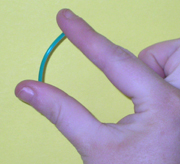 |
|
Advantages:
It
can work for three years but can be taken out at any
time.
You don't need to think about any other form of hormonal
contraception for as long as the implant works.
When the implant is removed a person's normal level
of fertility returns.
Disadvantages:
Periods
can often be irregular, much longer or may stop during
the first year.
Some
people can experience some weight gain. Other possible
side-effects include headaches, spotty skin, mood
changes, and breast tenderness.
Some
medicines may stop the implant from working.
back to top
|
| Male
Condom
|
|
|
The
male condom is made from a thin rubber called
latex. It is placed over the erect penis and
prevents sperm from entering the vagina, anus,
or mouth. Do not try to put the condom on when
your penis is soft. A condom should only be
put on when the penis is erect. When taking
the condom out of it's packet be sure not to
tear it; sharp fingernails and jewellery can
easily tear a condom.
|
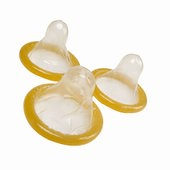 |
|
It
is very important that you use a condom with a quality
mark on the pack and that you have checked the expiry
date. Using a condom that is out of date is very risky
because there is a strong chance that the condom will
tear during intercourse.
It is also very important that you only use water
based lubricants with condoms. Using oil based products
such as Vaseline or Baby oil will damage the condom.
Check that the condom is the right way round. Do this
by checking which way it will roll. If you do have
problems rolling it on it is probably because it is
on inside out so you will have to start with a new
condom. With one hand squeeze the teat at the closed
end to get rid of any air and to leave a space at
the end for the sperm. While holding the teat with
one hand use the other hand to roll the condom right
down to the base of your penis.
When you are withdrawing hold the condom at the base
to stop it coming off and sperm leaking out. Never
throw the condom down the toilet. Wrap it in some
tissue and throw it in the bin.
The
male condom has many advantages. It is widely available.
It protects against Pregnancy and STIs, including
HIV, and may also protect against cancer of the cervix.
back to top
|
Natural
Family Planning
Natural family planning is a way to help a woman know
when she is most fertile. During the menstrual cycle,
a number of changes occur in a woman's body. If a
woman keeps track of these changes, couples can plan
when to have intercourse and when to avoid intercourse
or to use a barrier method.
Two methods of natural family planning are currently
taught. The first is the ovulation method. In this
method, the days just before and just after ovulation
(the releasing of an egg) are determined by checking
the woman's cervical mucus.
The second method is called the symptothermal method.
With this method, the woman takes her temperature
each day with a special thermometer and writes it
down on a chart. At the time of ovulation, a woman's
temperature will rise slightly. The woman also checks
the consistency of her cervical mucus. She may also
notice other changes, such as pain in the area of
the ovaries, bloating, low backache and breast tenderness.
In both cases a special chart is kept to track changes.
Use of these method requires training from a specialised
instructor and all of the instructions involved have
to be followed very carefully. If instructions are
followed correctly these methods can be 90-98% effective.
If instructions are not followed correctly the effectiveness
of these methods decreases greatly.
back to top
|
The
Combined Pill & Mini Pill
|
The
combined pill or The Pill as it is more commonly
known contains two hormones - Oestrogen & Progestogen.
The pill works by:stopping your ovaries releasing
an egg each month (ovulation).
Thickening the mucus from your cervix. This makes
it very difficult for sperm to get through it
to reach an egg.
Thinning the lining of your womb so it is less
likely to accept a fertilised egg.
The combined pill or The Pill as it is more commonly
known contains two hormones - Oestrogen & Progestogen.
The pill works by:stopping your ovaries releasing
an egg each month (ovulation).
Thickening the mucus from your cervix. This makes
it very difficult for sperm to get through it
to reach an egg.
Thinning the lining of your womb so it is less
likely to accept a fertilised egg. |
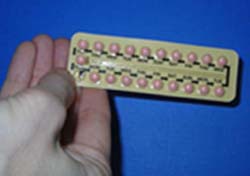 |
|
The
combined pill or The Pill as it is more commonly known
contains two hormones - Oestrogen & Progestogen. The
pill works by:stopping your ovaries releasing an egg
each month (ovulation).
Thickening the mucus from your cervix. This makes
it very difficult for sperm to get through it to reach
an egg.
Thinning the lining of your womb so it is less likely
to accept a fertilised egg.
|
The pill is taken every day for 21 days until
the pack is finished. There is then a seven day break
when you get a period. The next pack is started on
the eighth day. You need to take the pill at the same
time every day.
|
Advantages:
|
Doesn't
interfere with sex
Can make periods shorter, lighter, & less painful.
Protects against cancer of the ovary & the womb.
Reduces the risk of non-cancerous tumours in the womb,
cysts forming on the ovaries, and non-cancerous breast
diseases.
Can help with Pre-menstrual symptoms.
|
Disadvantages:
|
When
you first start the pill you may experience temporary
side effects. These include:
|
Headaches
Changes
In body weight
Breast tenderness
Bleeding between periods
Mood changes Increase in blood pressure
|
If
these symptoms persist you should speak to your GP
about changing the type of pill you use.
|
The
pill is not suitable for everybody. Some of the conditions
which might mean you should not use the pill are:
|
You think you might already be pregnant.
You smoke and are 35 or over.
|
You
have now or have had:
|
Blood clots
Heart problems or raised blood pressure
Severe migraines
Breast cancer
Liver disease
|
The
Mini Pill contains Progestogen only. The mini pill
works by:
|
possibly
stopping your ovaries releasing an egg each month
(Ovulation).
thickening
the mucus from your cervix. This makes it very difficult
for sperm to get through it to reach and egg.
thinning
the lining of your womb so it is less likely to accept
a fertilised egg
|
A
pill is taken every day until the pack is finished.
Unlike the pill you have no seven day break when using
the mini pill. A new pack starts as soon as the last
one is finished.
|
Advantages:
|
There
are no serious side effects.
It can be used if you are a smoker over 35.
Can be used while you are breastfeeding.
Can help with premenstrual tension and period pain.
|
Disadvantages:
|
Periods
may be irregular, lighter, or more frequent.
Temporary
side effects can include acne, and tender breasts.
Harmless cysts may develop on the ovaries.
|
You
should not use the mini pill if:
|
You
think you might be pregnant.
You are very over weight as this can limit its effectiveness.
You can discuss this issue with your GP.
|
You
also shouldn't use it if you have now or have ever
had:
|
A
heart attack or stroke
Liver disease
Breast Cancer
Cysts on the ovaries
|
How long do I need to be taking the Pill before it
starts working?
The length of time it takes for the pill to become
effective depends on the type of pill you are using
and when you start the packet. It is usually effective
within 7 days. You may need to use a barrier form
of contraception for the first 7 days(e.g. condom,
femidom, cap) to make sure that you don't get pregnant.
You also need to remember that other medications,
sickness, stomach upsets, diarrhoea, can have a bearing
on the pill's effectiveness. You should use a barrier
method of contraception at these times also.
back to top
|
|
|

